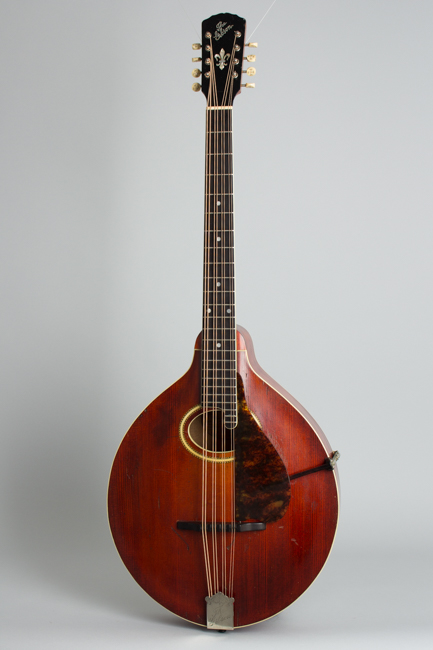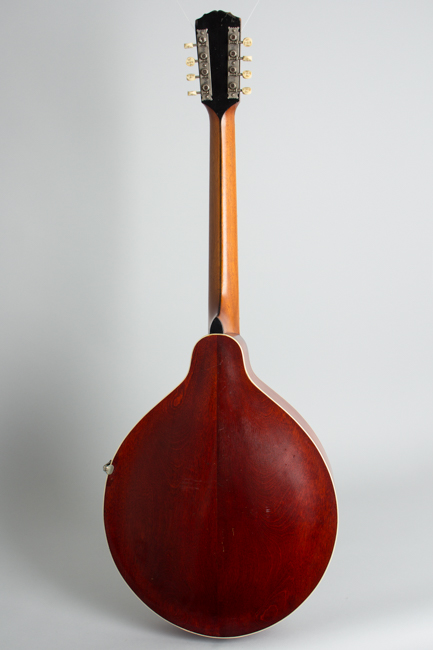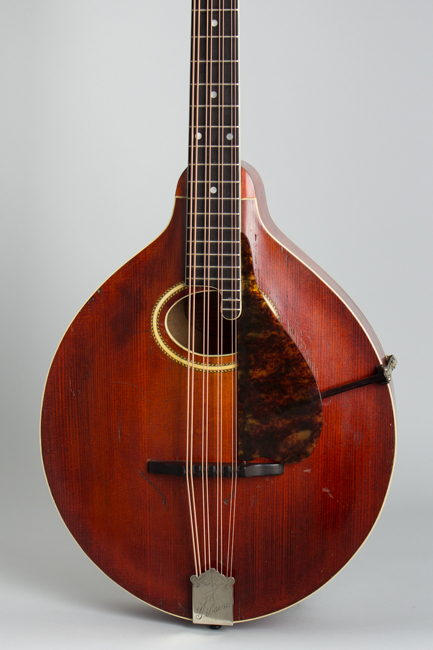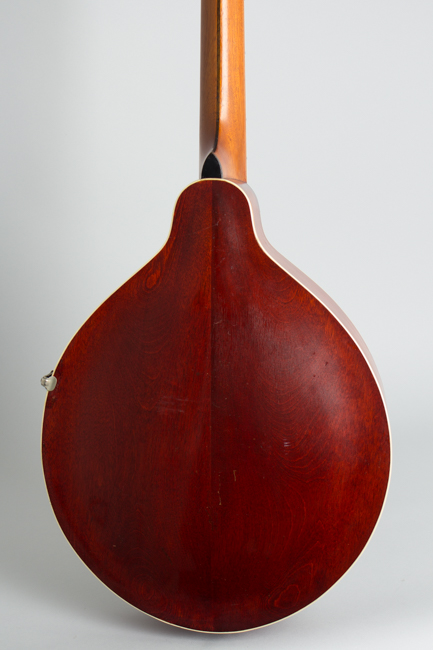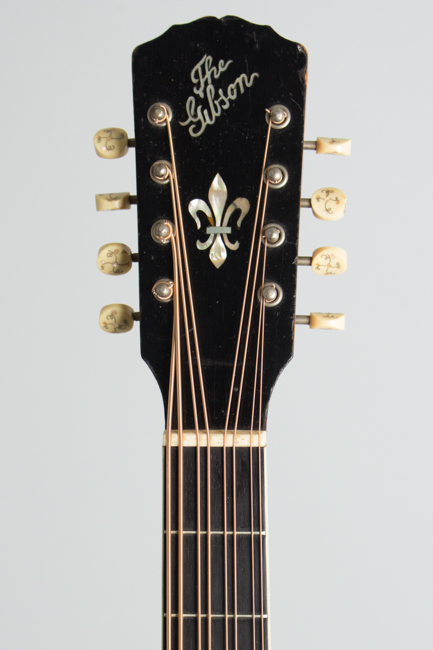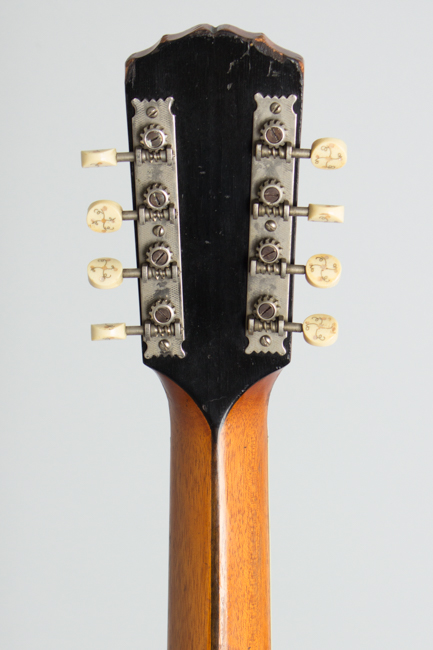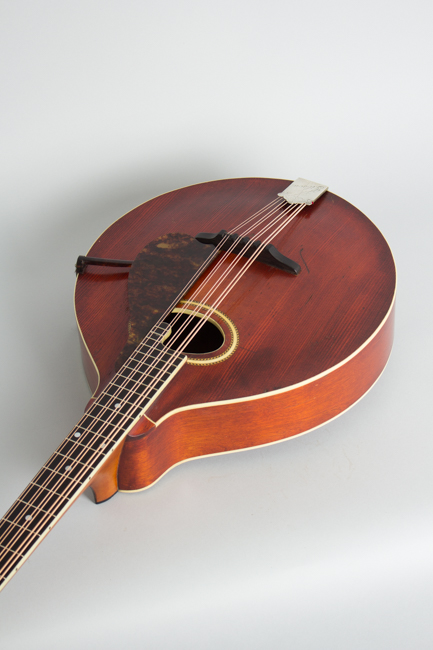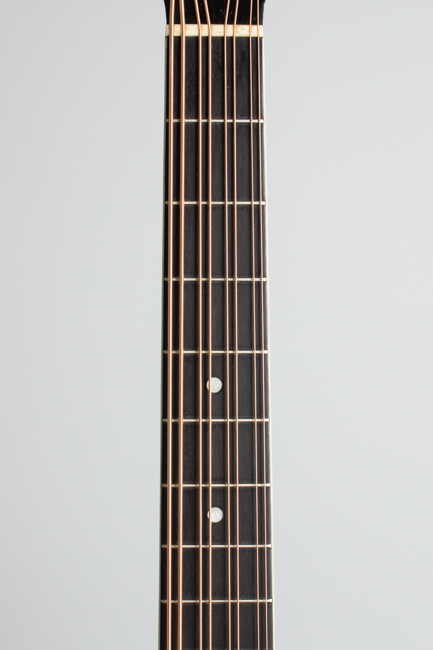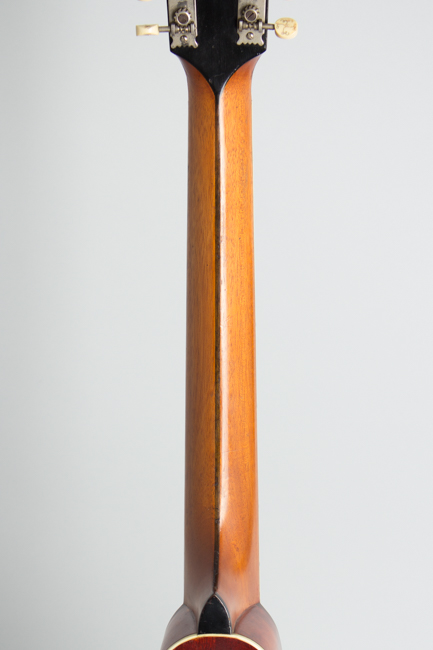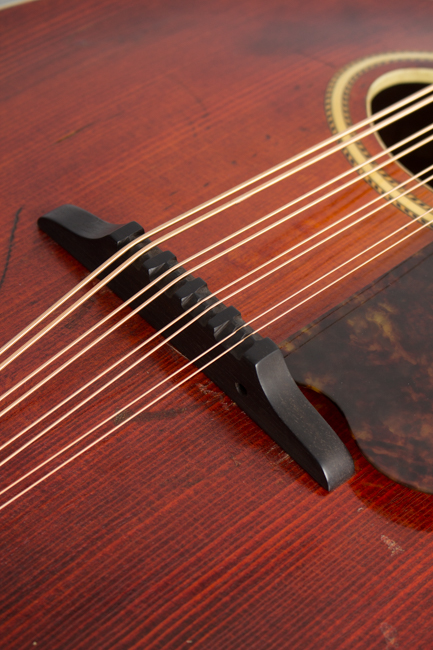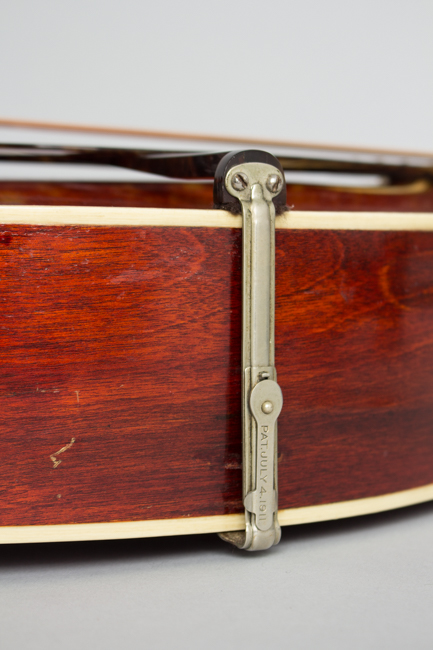Gibson K-2 Carved Top Mandocello (1914)
This item has been sold.
Item # 5876
Prices subject to change without notice.
Gibson K-2 Model Carved Top Mandocello (1914), made in Kalamazoo, Michigan, serial # 29539, sunburst top, dark cherry stained back and sides finish, birch back and sides, spruce top; mahogany neck with ebony fingerboard.
The Gibson Mandocello is one of the great under-appreciated instruments of the early 20th century. Originally designed for the 1910s mandolin orchestra craze, these imposing beasts never found a home in other styles of music despite being wonderful and unique-sounding instruments. Double-strung and tuned in fifths starting with the C below the low E on the guitar, the mandocello has an imposing tone and deep resonance unlike any other fretted instrument. OK, we're starting to sound like an old Gibson catalog here, but we really like these and are always happy to get one in stock!
This 1914 K-2 Mandocello dates to the decade when Gibson was defining the market for these mandolin family instruments. In the 1910s Gibson products were only available from licensed teacher-agents, and were usually purchased on a time plan along with lessons. As part of the deal, the students would often play in the teacher's fretted orchestra, and the low-tuned mandocello was crucial to achieving a full sound in these ensembles. Far fewer of them were sold compared to mandolins, however, and Gibson mandocellos from any era are a comparative rarity.
This particular instrument is a Model K-2, the midline model of the three mandocello models offered and at $50 (in 1914 dollars) a rather expensive instrument when new. It is structurally the same as the basic Model K-1 with some added "geegaw" (decoration). The headstock face carries an inlaid Fleur-de-Lys in pearl and abalone under the pearl "The Gibson" logo while the tuners are tipped with the beautiful inlaid Handel buttons. The sound hole is embellished with extra half-herringbone rings.
The K-2 package cost $15.00 more than the K-1 in 1914, which would have bought a pretty nice mandolin by itself from the likes of Sears. Other features were the same for both models, with a bound top, back, and ebony fingerboard. Often under-appreciated, the mandocello with its 8 strings and "C" orchestral tuning has a totally unique sound and can be useful for a wide range of playing styles, some yet to be explored!
Overall length is 38 1/4 in. (97.2 cm.), 14 1/4 in. (36.2 cm.) width, and 3 1/4 in. (8.3 cm.) in depth, measured at side of rim. Scale length is 25 in. (635 mm.). Width of nut is 1 5/8 in. (41 mm.).
This is a lovely example of this early 'teens Gibson Mandocello, well-played and with some old repair work performed in the past but still nicely original with a great sound. The finish has dings, dents, and a few deeper scrapes in the top. There is an old repaired area to the top near the rim on the bass side; a section of the spruce was cracked in several places along the grain and one cross grain spot, and this was solidly glued up long ago. The repair looks to have been done a long time ago and is not perfectly neat (it is visible and can be felt), but only minimal spot touch-up was employed; there is no heavy overspray or added varnish.
There are a few side cracks, also repaired in a similar manner but with a bit more finish work, again only locally applied. All parts are original (pickguard, Gibson engraved tailpiece, and beautiful Handel tuners with inlaid buttons) except for a handmade ebony bridge, similar to the original but slightly wider. This is a very fine-sounding mandocello, well past its 100th birthday with a richer voice than some from the period -- not to mention beautiful to look at as well! Overall Very Good + Condition.
The Gibson Mandocello is one of the great under-appreciated instruments of the early 20th century. Originally designed for the 1910s mandolin orchestra craze, these imposing beasts never found a home in other styles of music despite being wonderful and unique-sounding instruments. Double-strung and tuned in fifths starting with the C below the low E on the guitar, the mandocello has an imposing tone and deep resonance unlike any other fretted instrument. OK, we're starting to sound like an old Gibson catalog here, but we really like these and are always happy to get one in stock!
This 1914 K-2 Mandocello dates to the decade when Gibson was defining the market for these mandolin family instruments. In the 1910s Gibson products were only available from licensed teacher-agents, and were usually purchased on a time plan along with lessons. As part of the deal, the students would often play in the teacher's fretted orchestra, and the low-tuned mandocello was crucial to achieving a full sound in these ensembles. Far fewer of them were sold compared to mandolins, however, and Gibson mandocellos from any era are a comparative rarity.
This particular instrument is a Model K-2, the midline model of the three mandocello models offered and at $50 (in 1914 dollars) a rather expensive instrument when new. It is structurally the same as the basic Model K-1 with some added "geegaw" (decoration). The headstock face carries an inlaid Fleur-de-Lys in pearl and abalone under the pearl "The Gibson" logo while the tuners are tipped with the beautiful inlaid Handel buttons. The sound hole is embellished with extra half-herringbone rings.
The K-2 package cost $15.00 more than the K-1 in 1914, which would have bought a pretty nice mandolin by itself from the likes of Sears. Other features were the same for both models, with a bound top, back, and ebony fingerboard. Often under-appreciated, the mandocello with its 8 strings and "C" orchestral tuning has a totally unique sound and can be useful for a wide range of playing styles, some yet to be explored!
Overall length is 38 1/4 in. (97.2 cm.), 14 1/4 in. (36.2 cm.) width, and 3 1/4 in. (8.3 cm.) in depth, measured at side of rim. Scale length is 25 in. (635 mm.). Width of nut is 1 5/8 in. (41 mm.).
This is a lovely example of this early 'teens Gibson Mandocello, well-played and with some old repair work performed in the past but still nicely original with a great sound. The finish has dings, dents, and a few deeper scrapes in the top. There is an old repaired area to the top near the rim on the bass side; a section of the spruce was cracked in several places along the grain and one cross grain spot, and this was solidly glued up long ago. The repair looks to have been done a long time ago and is not perfectly neat (it is visible and can be felt), but only minimal spot touch-up was employed; there is no heavy overspray or added varnish.
There are a few side cracks, also repaired in a similar manner but with a bit more finish work, again only locally applied. All parts are original (pickguard, Gibson engraved tailpiece, and beautiful Handel tuners with inlaid buttons) except for a handmade ebony bridge, similar to the original but slightly wider. This is a very fine-sounding mandocello, well past its 100th birthday with a richer voice than some from the period -- not to mention beautiful to look at as well! Overall Very Good + Condition.
